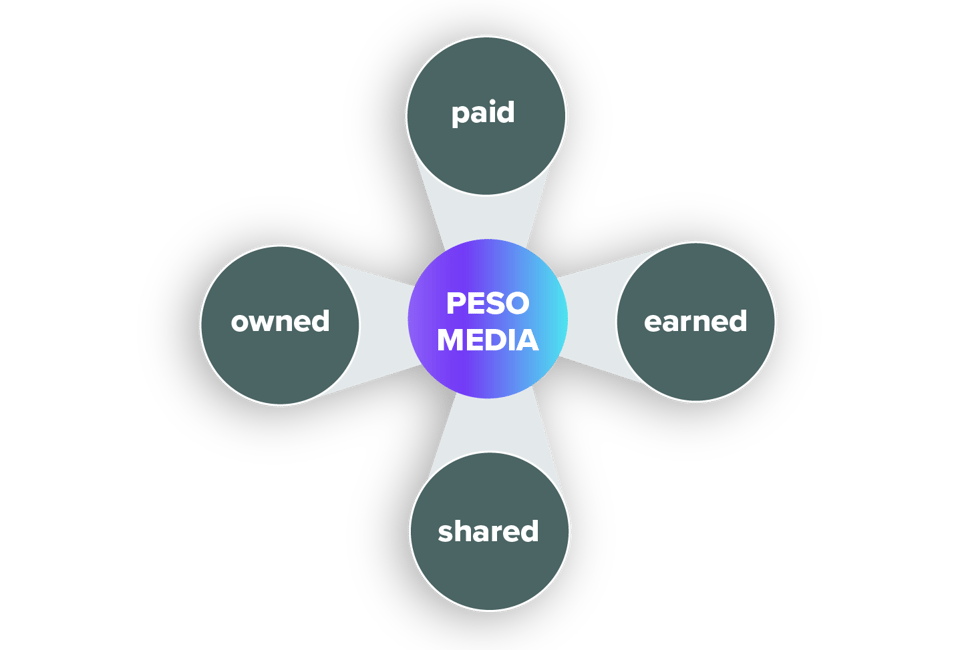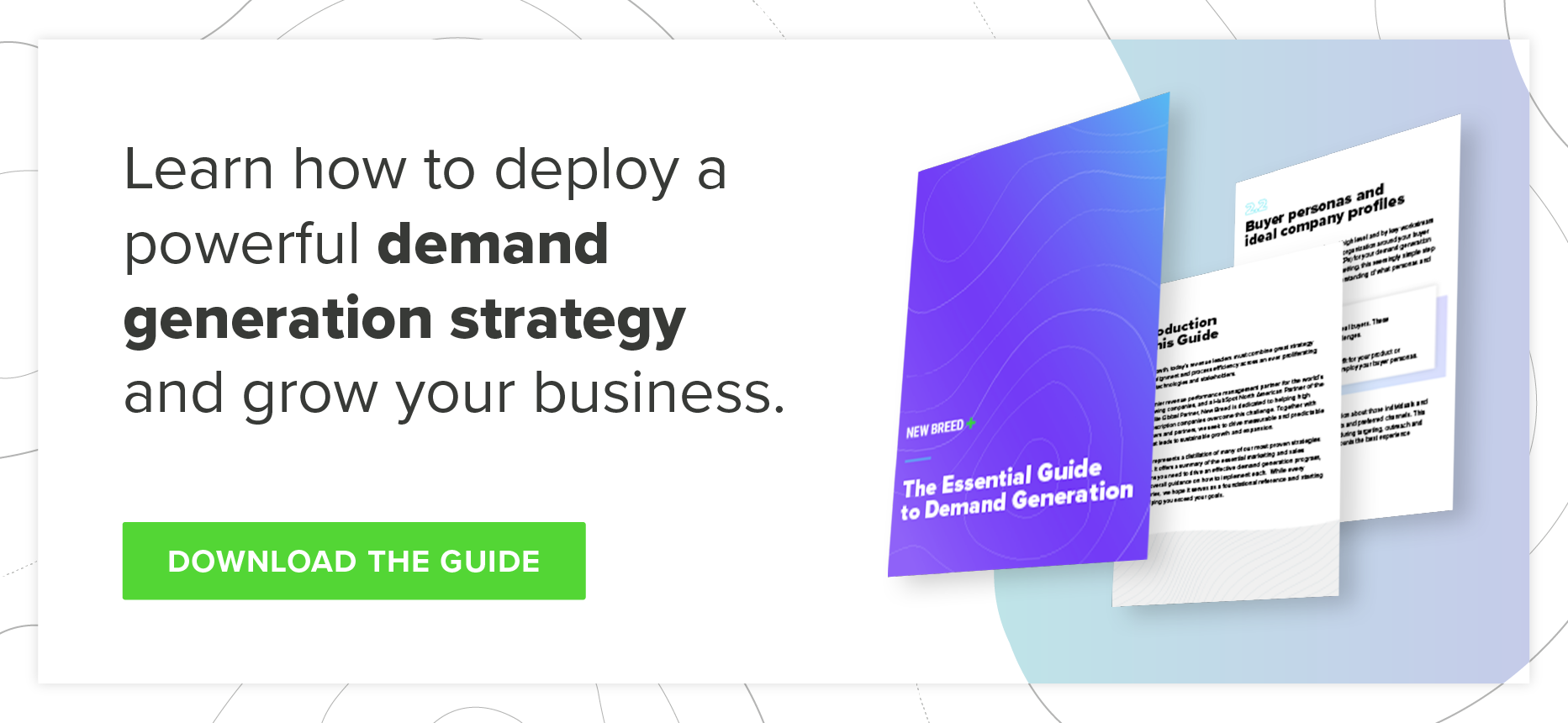Paid Media vs. Earned Media vs. Shared Media vs. Owned Media
As competition for attention rises in an increasingly crowded media landscape, brands find it tough to stand out. To make an impact on a target audience and draw qualified prospects into the funnel, marketers need to keep delving deeper into the strategic approach behind their content.
The PESO (paid, earned, shared, and owned media) model is the key to understanding how different content types contribute to Demand Generation. The model takes a 360-degree view of the content and distribution channel types at a marketer's disposal and how they intersect to create an integrated marketing campaign that maximizes the impact of a brand's message at every touchpoint of the customer journey.
By considering these formats when planning your content marketing strategy, you can ensure that your brand stands out in the crowd and reaches its potential in attracting leads and turning prospects into loyal customers.

TLDR; The Impact of Paid, Earned, Shared, and Owned Media
Although the strategic relationship between paid, earned, shared and owned media has been well documented for years, marketers are still figuring out how to best differentiate the different formats and when to use them. The challenge with each approach is that there are no absolutes, so defining criteria and targeting strategy will vary by business and industry. However, we do know that actively managing content through each of these channels gives brands the opportunity to leverage consumer voice in an increasingly sophisticated, targeted, and measurable way:
-
Paid media can quickly reach a large audience and drive conversions, while earned media is seen as more trustworthy and can increase the visibility of your brand.
-
Shared media is a great way to increase engagement and reach a wider audience, while owned media can be especially useful in showcasing a company's industry expertise and thought leadership.
Insights into mixed media strategies can guide brands to create powerful content that resonates with their customers. Understanding this model will ensure your brand reaches its maximum potential in attracting leads and turning prospects into loyal customers.
Paid Media: The Quick Reach Solution
Paid media refers to any content that you pay to place and promote. While you have a say in what's featured, keep in mind that there may be limitations set by the platform (like the stringent guidelines of Google Ads) or website host. These kinds of media assets often include:
- Search ads
- Paid advertising
- Paid affiliate marketing programs
- Advertorials
- Sponsored content
For B2B marketers, paying to promote their assets can be especially useful in targeting specific industries or job titles. Platforms like LinkedIn allow for highly specific targeting options, making it easier to reach the right decision-makers within a company. You can also use strategies like PPC to promote white papers, case studies, and other media content that can educate and persuade your audience. Just be sure to consider the minimum budget required per distribution channel to drive significant results in your funnel.
True to its name, this type of media comes with a hefty price tag and also a potential decrease in performance once payments stop. So for small and medium-sized businesses, it may not always be the most cost-effective solution. However, if you have a specific goal or limited time frame — think product launch — it's a quick way to reach a large audience and increase conversion rates.
Earned Media: The Trust Factor
Earned media is any content created by someone else about your brand that you didn't pay for. The idea behind this media strategy is "earning" third-party credibility via accreditation or expertise, relationship building with industry players, brand reputation and word of mouth, or other merits.
The earned media type can be incredibly valuable for a brand, as it is seen as more trustworthy than paid advertising. In fact, with the rise of social networking sites, the influence and value of earned media has increased in the recent decade. This category includes:
- Backlinks
- Word of mouth
- Features in listicles and roundups
- Press releases and coverage
- Awards
- Reviews and testimonials
Positive coverage in traditional or online media outlets can increase the credibility of your brand. Of course, the most effective way to get earned media is to do something newsworthy. But you can also use other forms of media to get earned attention. If you publish research and promote it via paid channels, that’s using company-owned and paid promotion to garner earned media and reap the rewards of third-party recognition.
As a downside, earned media can be tough to control and predict; there's no guarantee that the content published about your brand will be positive in nature. Plus, building relationships with media outlets and influencers can take time and effort that may halt immediate performance results.
Food for thought: When naming examples of earned media strategy, some marketers claim that organic traffic performance is considered "SEO earned media." They state that since brands can't directly control search performance and rely on algorithms to reward them for valuable content, they don't qualify under brand ownership.
Shared Media: The Engagement Boost
Shared media is content that is distributed across social media or exchanged between multiple owners. It doesn’t have a concrete, explicit definition, because as social media evolves, shared media changes, too. However, any approach that relies on social sharing or influencer marketing will typically fall under this media. Typically, the category includes:
A strong shared media strategy is a great way to increase engagement. By creating shareable content catering to the challenges and interests of their customers, marketers can increase brand awareness and drive traffic to their websites.
Plus, it's a valuable tool for building a community around your brand and attracting influencers in your industry. By actively engaging with your audience on social media and encouraging user-generated content, you can increase brand awareness, reach, and loyalty.
The con of shared media is that you have no control over the reach of the content. If someone makes a meme mocking your product, you can’t stop it from going viral. Plus, with the rise of AI content and misinformation, be cautious when sharing or endorsing user-generated content.
Owned Media: The Control Factor
Owned media is the foundation of content marketing. This is any type of brand content and distribution channels that you create, own, or control yourself — from your website and video content to go-to-market strategy documentation. In general, this kind of media includes:
Media based on your own domain, like a blog post, or one that you fully control, like social media, can be especially useful in showcasing your thought leadership. Creating insight-rich, valuable content that speaks to the persona's pain points helps marketers attract and educate qualified, high-intent prospects. By having more control over the message and reach of the content, you can rest easy that your messaging strategy aligns with the brand and targets your desired spaces in the market.
However, creating and distributing the media you own often requires significant time and resource investments. And because content based on organic channels like Google can take months to appear in search engine results (SERP) or not surface at all, this media strategy may not reach as wide of an audience as quickly as paid or shared media.
The Intersection of Paid, Earned, Shared, and Owned Media
Paid, earned, shared, and owned media are frequently used together. Press releases are owned media promoted through paid media in an effort to get earned media. Reviews are earned media, but when a company publishes them on its website as a testimonial, they turn into the property of that brand, and so on.
Here's an example of media intersection when optimized for lead generation and revenue performance:
When New Breed co-hosts a webinar with a partner, our team produces and owns the content. However, for our partner, the same content functions as positive earned media. Their expertise led to an invitation to participate, in turn increasing their brand's reach with backlinks and promotions on our owned media channels.
Post-webinar, we decide to continue the conversation by posting the recording on our social media channels. As the post gains likes and social shares, we decide to boost the webinar on paid channels targeting industry influencers in our CRM. As a result, New Breed gains free placement in a prominent industry publication for thought leadership, skyrockets in search results due to brand mentions, and welcomes loyal customers.
The Takeaway
The key to leveraging each type of media is to develop a detailed strategy. Start with your goals and use the PESO model to devise tactics that will move different personas down the funnel towards purchase. It's all about getting a return on your investment and adding value for your customers. As in any marketing strategy, you want to measure results and adapt along the way based on the insights derived from your efforts.
If you're looking for more insights on how to generate demand for your products or services, check out our "The Essential Guide to Demand Generation" for a detailed overview of the latest trends and best practices in demand generation. Download it now to take your marketing strategy to the next level!
Elizaveta Shkurina
Sr Creative Strategist specializing in B2B brand creation, sales enablement, and SaaS demand generation. With 8 years of experience, she excels in driving ROI and revenue-driven KPIs through collaborative innovation.






